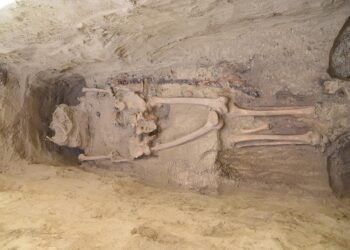Ancient humans, resilient and adaptive, faced the cataclysmic eruption of Mount Toba in Sumatra some 74,000 years ago, as revealed by groundbreaking research spanning Ethiopia’s Shinfa-Metema 1 archaeological site.

This eruption, among the largest in Earth’s history, sparked debates among scientists regarding its impact on early human populations. Recent findings challenge this apocalyptic narrative.
Led by John Kappelman from the University of Texas at Austin, a multidisciplinary team meticulously examined clues unearthed at Shinfa-Metema 1. The site, nestled near the Shinfa River in northwest Ethiopia, witnessed human occupation before, during, and after the Toba eruption, presenting a unique window into our ancestors’ response to adversity.
Through microscopic analysis of volcanic glass fragments, or cryptotephra, researchers pinpointed the eruption’s timing, demonstrating its coincidence with human presence at the site. These minuscule glass shards, barely larger than a human hair, enabled precise dating and correlation of archaeological sites across vast distances.
Far from succumbing to catastrophe, early humans at Shinfa-Metema 1 thrived amidst the volcanic aftermath. Evidence suggests they adapted their diet to capitalize on the changing landscape, with a notable increase in fish consumption as waterholes dwindled during prolonged dry seasons post-eruption. This dietary shift, coupled with innovative hunting techniques evidenced by the discovery of ancient arrowheads.
Contrary to previous assumptions of mass extinction, this research paints a picture of resilience and adaptation. Ludovic Slimak, a researcher at the French National Centre for Scientific Research, says: “This study demonstrates the great plasticity of Homo sapiens populations and their ability to adapt easily to any type of environment, whether hyper-humid or hyper-arid, including during catastrophic events such as the hyper-explosion of the Toba volcano.”
Moreover, the findings suggest a paradigm shift in our understanding of human dispersal from Africa. Rather than being confined to “green corridors” during periods of abundance, ancient humans may have utilized “blue highways” — seasonal rivers — during arid intervals, facilitating their movement and expansion. This newfound perspective challenges conventional narratives surrounding human migration.





















